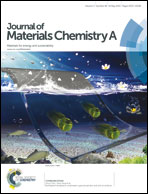In situ growth of CuS and Cu1.8S nanosheet arrays as efficient counter electrodes for quantum dot-sensitized solar cells†
Abstract
Vertical CuS nanosheet arrays were synthesized in situ for the first time on transparent conducting fluorine-doped tin oxide (FTO) substrates via a facile solvothermal process of seeded FTO glasses in the presence of ethanol solvent only containing thiourea and Cu(NO3)2 as a precursor. While choosing CuCl instead of Cu(NO3)2 as the copper precursor in the same solvothermal process, porous Cu1.8S nanosheets, for the first time, were also vertically grown on FTO substrates, suggesting that such a synthesis process is a general approach for the preparation of copper sulfide nanosheet arrays. When used as low-cost counter electrode materials in quantum dot-sensitized solar cells (QDSSCs), CuS (3.95%) and Cu1.8S (3.30%) nanosheet films exhibited enhanced power conversion efficiencies in comparison with the conventional Pt film (1.99%), which was primarily due to the excellent electrocatalytic activity of copper sulfides for the reduction of the polysulfide electrolyte used in CdSe/CdS QDSSCs. Significantly, the in situ growth strategy largely simplified the fabrication procedure of copper sulfide counter electrodes and, meanwhile, enhanced the adhesion between films and substrates.


 Please wait while we load your content...
Please wait while we load your content...